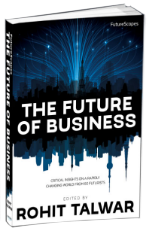03 Jun Can Technology Fix the Cost Crisis in Healthcare and Education?
 Most personal insolvencies these days are caused by expenses related to the two service industries we depend on the most in our modern society – healthcare and education. And not surprisingly some of the most disruptive technological and social innovations are happening in these two areas as well.
Most personal insolvencies these days are caused by expenses related to the two service industries we depend on the most in our modern society – healthcare and education. And not surprisingly some of the most disruptive technological and social innovations are happening in these two areas as well.
Much of the skyrocketing healthcare costs in the United States have been attributed to lack of preventative care. Obesity rates have climbed in response to insufficient physical exercise and nutritional ignorance or at least by our slant toward self-deluding eating habits. Health monitoring and simple checkups add to the costs and time spent in doctor’s offices.
The Quantified Self movement is a reaction to this problem by making healthier choices more compelling. Around 1000 health apps for phones and tablets are released every month. The frenzied following of gadgets like Fitbit and the growing use of game logic to stir motivation in various types of task performance and learning might continue to push down the now leveled off obesity rate. Not only do these user friendly doohickeys nudge people into eating correctly and exercising more, but they can also amass large amounts of health data, which I’m sure is attracting great attention from public health researchers. All this data dissemination can be a double-edged sword, or at least a sword that hang over you reminding you to never slack off (did someone mention higher stress levels?). Also I’m not sure to which degree use of this data is restricted by the HIPAA rules, but there might be legit purposes if it’s decoupled from personal identity information. With all this data private physicians, insurers and public services could better streamline their services to better serve individual and well as geographic regions and demographic strata.
There’s a similar revolution happening in education. With a pending student loan crisis (at least crisis for the debtors) and rumors of a student loan bubble, the sturdy ground under ivory towers are starting to shake. The longstanding notion that any education will pay off is losing steam and trust in the investment potential of student loans might be on track to where Fanny Mae and Freddy Mac were headed about a decade ago. Ownership does not always pay off – even if that ownership is a prestigious sheepskin diploma. But the alternative is no better. Refraining from pursuing an education might leave you debt free, but also put you in no position to compete outside of the narrowing and outsourced blue-collar job market. These limitations may bring just as much misery to the academically inclined as a hefty loan. Here is where the MOOC revolution comes in. The last couple of years have seen an astounding increase in freely available courses from institutions like Khan Academy (I retook the GRE test last year, depending fully on Khan to re-teach me the high school algebra I had forgotten!) as well as a cornucopia of individual courses from various stellar universities. Udacity, Coursera, edX and MITx are just the beginning. Some even offer college credits for some classes.
But even MOOCs have their limitations. One issue is the low completion rates. For some, ambition is only as high as the bar of entry, which in this case is no higher than filling out an online registration form. I would think the self-discipline these courses require is particularly problematic for younger students. There is also the absence of student collaboration and colloquium driven motivation that takes place in a brick-and-mortar institutions. Secondly, the courses offered are not full degrees resulting in graduation papers, but leaves the student with a ‘certificate of mastery’ at best. Some courses, especially the “introductory type” ones have a noticeable ‘freebie’ feel to them where you have to pursue full enrollment to really get somewhere. Then we’re back to point blank with high tuition costs.
For the MOOC experience to really catch on it needs better social infrastructure. It also should result in useful metrics and certifications to justify the time investment. The social part could possibly be overcome by meshing the MOOC phenomenon with the Quantified Self phenomenon. When will the Fitbit gadget get a brainy little brother called ‘Edubit’? It’s time to ‘socialify’ (is that a word?) and gamify the MOOC process.
Futurist Dr. Maria Anderson has an extraordinary vision for the future of learning. She wants to create a new ‘ecosystem’ for personalized learning, even a mentor driven certification process. She theorizes that this will start outside of the traditional educational sphere and then trickle in through the ivy covered (pay-) walls of traditional universities. When learners find online material they want to learn they should be given the opportunity to re-engage with the material through a “Learn This” type button, borrowing from the same interactive tools we now use to ‘like’, ‘share’ and distribute over our social media networks. Dr. Anderson’s point is that we have vast access to information already. In fact we’re drowning in information. The challenges lie within systemizing it, internalizing it and receiving external validation for acquiring one’s expertise.
Please let her explain in her own words:
[Embed yotube clip: http://www.youtube.com/watch?v=m5kAOE3x1aY]
We seem to be undergoing a trajectory of Moore’s Law (the idea that computing power doubles every other year) in education. The amount of knowledge we have to harness over our lifetime seems to multiply, but yet, the return on our educational investments continue to drop.
This might not be especially comforting for the many underemployed Millennials and Gen X’ers who are drowning in student loans. But it does open some new doors as education becomes less dependent on paying power. As with personal health management, the next step is to ensure that these new affordable tools for learning demonstrate lasting results. The way younger Millennials and Homelanders acquire skills and knowledge will bear witness to the longevity of these trends.
Images: cooldesign @ FreeDigitalPhotos.net, YouTube, Mashable


Sorry, the comment form is closed at this time.